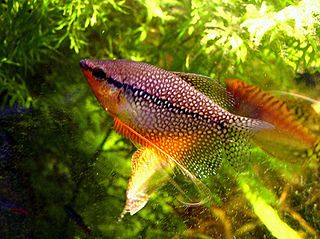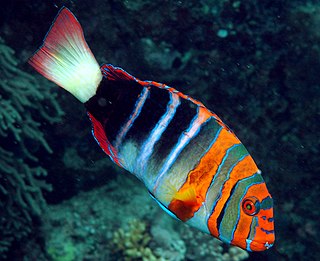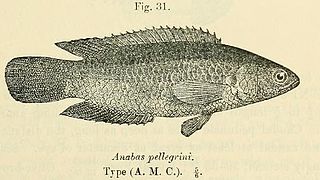
Philibert Commerson, sometimes spelled Commerçon by contemporaries, was a French naturalist, best known for accompanying Louis Antoine de Bougainville on his voyage of circumnavigation in 1766–1769.

The pearl gourami is a species of gourami native to Southeast Asia.

Trichogaster is a genus of gouramis native to South Asia from Pakistan to Myanmar. It is the only genus in the monotypic subfamily Trichogastrinae as set out in the 5th Edition of Fishes of the World, although that book states that there are two genera, the other being Colisa which is treated as a synonym of Trichogaster by Fishbase and the Catalog of Fishes. Fishbase also places the genus in the Luciocephalinae. Species of this genus are very popular in the aquarium trade.

Choerodon is a genus of wrasses native to the Indian Ocean and the western Pacific Ocean. They are commonly referred to as tuskfish, because most species have sharp tusk-like teeth.

Parascorpaena is a genus of marine ray-finned fish belonging to the family Scorpaenidae, the scorpionfishes. They are native to the Indian Ocean and the western Pacific Ocean.

Parapterois is a genus of marine ray-finned fishes belonging to the family Scorpaenidae, the scorpionfishes. These fish originate from marine environments in the Indian Ocean or near it. The venomous Parapterois heterura is occasionally seen as an aquarium fish.

Trichopodus is a genus of tropical freshwater labyrinth fish of the gourami family found in Southeast Asia. Gouramis of the genus Trichopodus are closely related to those of Trichogaster ; species of both genera have long, thread-like pelvic fins used to sense the environment. However, Trichopodus species have shorter dorsal fin base and, when sexually mature, are much larger, with the largest, the snakeskin gourami, capable of reaching a length of over 8 in (20 cm).

The Highland splitfin is a species of splitfin endemic to Mexico where it is found in the Lerma River basin. This species grows to a length of 5 centimetres (2.0 in) TL. It is the only known member of its genus, although some authorities have Hubbina as a subgenus of Girardinichthys and add Girardinichthys ireneae to the subgenus, even treating this taxon as a synonym of G. ireneae. This species was described by Don Fernando de Buen y Lozano in 1940 with the type locality given as Cointzio, Michoacán. The name of the genus honours the American ichthyologist Carl Leavitt Hubbs (1894-1979) while the specific name honours Clarence Lester Turner (1890-1969), thus honouring two ichthyologists who worked on a review of the Goodeidae in 1939.
Microctenopoma damasi is a species of fish in the family Anabantidae. It is found in the Democratic Republic of the Congo and Uganda. Its natural habitat is rivers. This species was formally described in 1939 as Anabas damasi by the Belgian ichthyologist Max Poll, the type locality given was Semliki River at Ishango in the Democratic Republic of Congo. The type was collected by Hubert Damas (1910-1964) of the University of Liège and when he described the species Poll named Damas as co-author, this meant that Damas was the co-author of a specific name which honoured himself.
Phallostethus dunckeri is a species of fish in the family Phallostethidae. It is endemic to Malaysia.
Teramulus kieneri, the Keiner's silverside or vily, is a species of silverside endemic to Madagascar where it is found in rivers around on the eastern coast. This species was described by J.L.B. Smith in 1965 with the type locality given as the coastal swamps near Tamatave. It has since been found in other areas of the island, including the basin of the Nosivolo River and in the Bemarivo River. Smith gave this species the specific name keineri to honour the French fisheries scientist, André Kiener, who assisted in the collection of the type in 1961, although it was initially reported as Atherinomorus duodecimalis. It is the type species of the genus Teramulus.

The black scorpionfish, also known as the European scorpionfish or small-scaled scorpionfish, is a venomous scorpionfish, common in marine subtropical waters. It is widespread in the Eastern Atlantic Ocean from the British Isles to the Azores and Canary Islands, near the coasts of Morocco, in the Mediterranean Sea and the Black Sea.
Enneapterygius williamsi, known commonly as the William's triplefin, is a species of triplefin blenny in the genus Enneapterygius. It was described by Ronald Fricke in 1997. Its specific name honours the collector of the type, the ichthyologist Jeffrey T. Williams of the Smithsonian Institution.
Betta strohi is a species of gourami endemic to Indonesia. This species grows to a length of 7 centimetres (2.8 in) TL.

The Malay combtail is a species of gourami native to southeast Asia where it is found in peat swamps of the Malay Peninsula and the Greater Sunda Islands. This species can reach a length of 20 centimetres (7.9 in) SL. It is a commercially important species and is also found in the aquarium trade. This species was formally described by Georges Cuvier in 1831 with the type locality of Java. The collector of the type was collected in 1820 by the Dutch physician and biologist Johan Coenraad van Hasselt (1797-1823), whom Cuvier honoured in its specific name, with his friend Heinrich Kuhl.

Ctenopoma pellegrini is a fish in the family Anabantidae found in the Congo River basin of Africa. It grows to 11.2 cm in total length for a male/unsexed specimen. This species was formally described by the British-Belgian ichthyologist George Albert Boulenger in 1902 with the type locality given as Yembe River at Banzyville in the Democratic Republic of Congo. Boulenger honoured the French ichthyologist Jacques Pellegrin (1873-1944).

The blunt-snouted clingfish is a species of clingfish found along the western Mediterranean Sea coasts from Spain to Italy. This species grows to a length of 5 centimetres (2.0 in) TL. The blunt-nosed clingfish is a little known species of shallow water along the littoral of the northern Mediterranean from Alicante to Sicily. Its range was formerly thought to extend to Israel and Syria in the east; however this was actually several closely related cryptic species. It can survive out of the water and occurs only among intertidal pebbles and sand.

Neosebastes is a genus of marine ray-finned fishes, belonging to the subfamily Neosebastinae, the gurnard scorpionfishes, part of the family Scorpaenidae. These fishes are found in the Indian and Pacific Ocean.

Pseudosphromenus dayi is a species of freshwater ray finned fish from the subfamily Macropodusinae, part of the gourami family Osphronemidae. It occurs in Kerala on both the coastal regions and the Western Ghats. It is a species of still or slow flowing waters, especially lakes, ditches and swamps in both fresh and brackish waters. Pseudosphromenus dayi is a bubble nester, the male creates a nest made of bubbles under an overhang or a leaf. The females lays eggs which drop to the substrate and are picked up by both fishes in the pair and placed in the bubble nest. The name Polyacanthus cupanus dayi was first published in 1908 by Köhler in 1908 but Catalog of Fishes refers to this as a nomen nudum and attributes the valid use of the name, with a formal description, to P. Engmann in 1909. The type locality is given as Malacca which is probably an error and should be Kerala. The specific name honors the British ichthyologist and author of the Fishes of India, Francis Day (1830–1889).

The humpbacked scorpionfish is a species of venomous marine ray-finned fish belonging to the family Scorpaenidae, the scorpionfishes. This species is found in the western Indian Ocean.

















